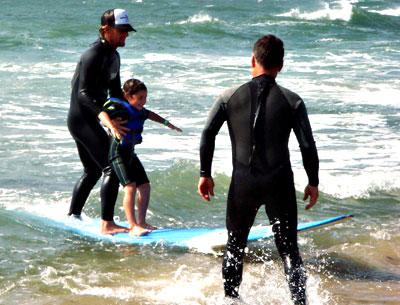The Science-Surf Connection

It’s Sunday morning. We have just lifted off in the rain from J.F.K. bound for San Diego, where the plan is to rent a car for the short drive north to San Clemente, home of the Surfing Heritage Foundation. The foundation archives surfing history and works to protect access to surf spots around the world.
I’ll be meeting with the foundation’s executive director, a man of Hawaiian lineage, and a surfing god of sorts, a legend in his own time beginning in the 1960s in the waves of Waikiki.
I know this because back then I was part of what was called the Tongs Gang, a group of young surfers who hung at a secret sort of spot way to the east of Waikiki proper, closer to Diamond Head. Regulars at Tongs and the breaks known as the Winch and Rice Bowl included Paul Strauch, Sammy Lee, Jeff Hackman, and a number of other surfing pioneers who were moving the sport forward stylistically and outward geographically.
Although I grew up on Long Island, I happened to spend three summers there starting in 1963 at the age of 14 by virtue of the fact my father was a hospital administrator who found consulting work that paid for our family’s extended summer holidays. Lucky for me. Surfing as a sport and lifestyle was just beginning to catch fire on the mainland.
Fast-forward to my watching the jet exhaust pour from the starboard engine of our Jet Blue chariot as it charged down the runway on Sunday. Yup, the same exhaust and the millions of similar carbon expulsions helping to overheat the earth worldwide.
A good part of my reason for becoming involved in the creation of the Oceans Institute of the Montauk Lighthouse Museum, a k a the Montauk Surf Museum, is to make the science-surf connection in people’s minds — not only to explain the meteorology, geography, and oceanography that makes and shapes waves, but to get across to the uninitiated the love of the sea, and the accompanying desire to protect the marine environment, that comes from making oneself part of it.
Many will remember the summer months back in the ’90s when “red-bag waste,” that is, medical waste including syringes, was washing up on Long Island beaches. The Star carried a number of stories about the effort to control the dumping of garbage, including red-bag waste that was being dumped at the 106-mile offshore site located in the New York Bight, halfway between New York and New Jersey. At the time, barge operators were making a habit of dumping well shoreward of the dumpsite.
For many, the red-bag summers, and before that the outrage over leaks in the pipeline that carries untreated sewage off the south shore of Long Island at Bergen Point, placed the concept of ocean pollution in their minds for the first time.
We are terrestrial beings for the most part, although mariners — including fishermen, and especially surfers, who share the slime of oil spills and infections from sewage with their fish and marine-mammal counterparts, not to mention bearing witness to the plastic strangling of turtles and birds — are in a position to be the canaries in the marine coal mine.
The environmental legacy of thinking surfers is becoming more profound by the year, and I believe the Oceans Institute will help spread the word.
During the week just past The New York Times ran two front-page stories, one about the damage being done to the sea by human activity. Most of it comes from habitat destruction and over-fishing. (Although one should be careful to identify the real culprits. The United States has a good track record in regulating fishing, relatively speaking.) Then there’s mining on the sea floor, plastic pollution, careless oil drilling, container ships striking migrating whales, you name it.
But perhaps the most destructive element is the warming of the earth via greenhouse gases now in the process of drastically altering the habitats of nearly all sea life from corals up through the various food chains that sustain life on earth. Our local fishermen are beginning to see its effects in real time.
Surfing is not just riding waves. I’m hoping that the Surfing Heritage Foundation will help Montauk’s new Oceans Institute emphasize, in the public mind, the good that can come from an intimate appreciation of the sea.
Paul Strauch visited Montauk last fall to see how the foundation might help the Oceans Institute, and how the institute might further the foundation’s efforts to collect East Coast surfing history.
He said the Heritage Foundation was already involved in displaying efforts that show how the petroleum-based resins used in making surfboards and wetsuits might be replaced. A display that shows surfboard builders using sustainable materials could be one of the Montauk Surf Museum’s first events.
Now, if we could just find a technology, or the time, to go surfing in far away places without jet fuel.
